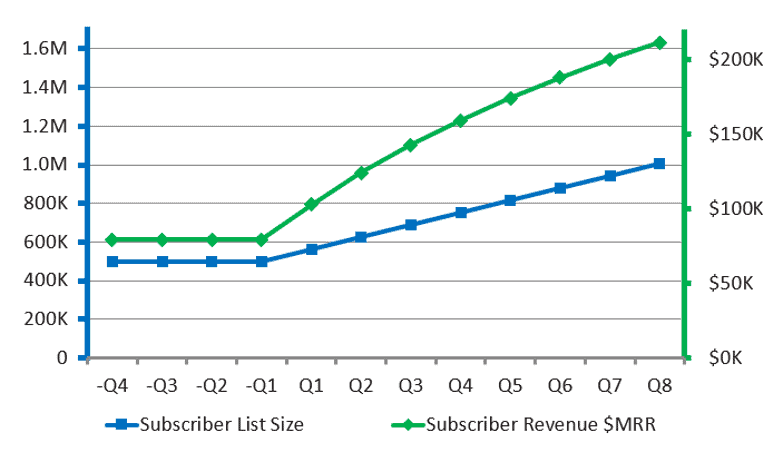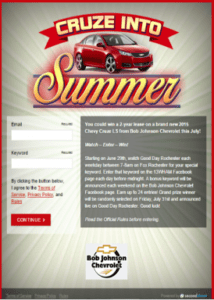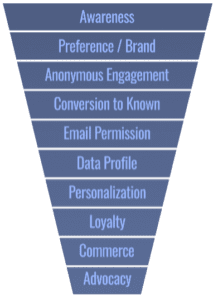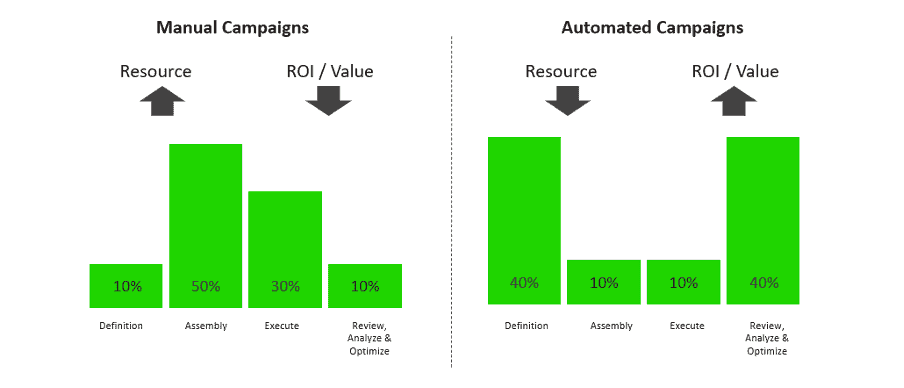It feels like publishers and media companies have been under attack from all angles. Whether it be society’s move to digital, attitudes towards paid-for news, the removal of 3rd party cookies, mobile app privacy updates, or social media platforms taking market share away from them, anyone in the email marketing for publishers world has probably grown a few grey hairs over the last couple of years.
The result of all these changes is that revenue opportunities are either declining or in constant flux, and brands are moving their advertising budgets to social media platforms instead.
Email marketing is still an excellent way for publishers and media companies to generate revenue from their database and satisfy their subscribers with up-to-the-minute content and their advertising partners with ads targeted at relevant, segmented lists that convert.
For email marketing to be successful, there are several tactics that these companies can deploy to maximize their revenue across different forms of email communications, be it a regular newsletter, a compelling offer, or breaking news alerts.
Common issues impacting the Media industry
- Shrinking email databases
Modern data privacy regulations, consumer attitudes toward their email inbox, and, frankly, poor email strategies compound the fact that email lists are shrinking, not growing. In fact, across our 1000+ customer brands in publishing and media, we’ve found that as much as 30% of their email database can churn in any given year. - Capturing first-party data is tough
Consumers are savvier about how their data is used and make decisions many times a day about who to share or not share their data with. Highly publicized misuses of data by the likes of Facebook, have propelled issues around data monetization to the world, and has made them more careful about what they do and don’t sign up for. Add to that, a new age of consumers who believe that news and content should be free and capturing first-party data can be challenging. - The modern subscription economy puts pressure on paid-for content
When a consumer has monthly paid subscriptions to Netflix, Amazon, Disney+, Spotify, mobile phones, etc., the monthly cost can quickly add up, and they will inevitably make choices about which to keep and which to stop. Paid subscribers for publishers and media companies come under threat as more and more companies move to subscription models. Therefore, being relevant, useful, and personalized is more paramount than ever before to retain paying subscribers. - Third-party data for advertising is going away
The removal of third-party cookies from the digital ecosystem will be a rough ride for publishers and media outlets that depend on the ad revenues from 3rd party data. Brands will no longer be able to easily serve up an advert to a consumer on a publisher’s website using current methods. They will look for other ways to be targeted with their advertising – ultimately pumping more budget into Facebook and Google.
How can publishers use email marketing to generate more revenue?
While we wait for the effectiveness of 3rd party cookies to fade away, email marketing is an area of focus for publishing and media brands to be able to claw back some of the revenue that could disappear. Here are some tactics and strategies that we’re advising our customers to implement in 2022:
1. Focus on email database growth
Although this is a relatively simple piece of advice, there are many ways that businesses can rapidly increase their audience acquisition, collect more meaningful first-party data in the process, and then prevent churn from existing subscribers too. On average, new subscribers have 2X the engagement of older subscribers, so any increase in your email subscriber list will have a compounding positive impact on revenue, as seen below:

As you’ll see, the correlation between new subscriber growth and monthly recurring revenue (MRR) shows how new subscribers are more engaged and spend more.
A strong, always-on audience acquisition strategy is paramount to achieving better revenues through advertising and sales. The great thing for publishers is that you have a treasure trove of currently anonymous, repeat visitors to your sites. Visitors that are ready and waiting to be converted into immediate 2X revenue growth.
Contests, polls, and sweepstakes
Successful brands are utilizing contests, polls, sweepstakes, and fun, interactive media on their websites, eCommerce, and apps to convert more users, collect more data, generate more opt-ins, and better understand those users in the process:

As well as increasing your subscription lists, these contests can capture additional, emotive data that can be used to better personalize content and adverts to an individual. Do they prefer blue to red? Are they a lover of cats or dogs? Wine or beer? What type of holidays do they prefer? How do they keep fit? What’s their favorite football team?
Publishers can start to build up these strong, emotive data points to power contextual targeting for your advertising partners and customize content for your audiences too. By adding this data to your email segmentation, or into a CRM or Customer Data Platform, you can build rich profiles of your subscribers and opted in audiences to provide as advertising segments, and then offer up dynamically personalized ads in email newsletters that have a higher propensity to interest an individual user.
For cat lovers, it could be a charity donation to a nearby cattery; for the keep fit segment, why not invite them to the opening of a new gym, etc.
2. Subscriber retention
To retain your valuable subscribers, you need to offer value. Remember, your audiences have many subscriptions to other services and apps which you’ll be competing with. As the cost of living rises around the world, the pinch on consumer finances inevitably leads to a choice between your subscription or the Netflix monthly bill, or the Amazon Prime membership.
To provide value, you need to understand each subscriber at an individual level, provide easy and frictionless ways to manage their account, and ensure that if a subscriber is likely to churn, you have ways to keep them, re-engage with them, or win them back. Subscribers could be churning for any number of reasons, so understanding those reasons is essential. If a subscriber is leaving you because they’ve moved location and your local news is less relevant, then there’s not a lot to be done (unless you’re a national brand with many regional news properties that could represent the chance to switch their account.) However, if it’s a financial reason, then perhaps there’s a cheaper tier they could move down to, or perhaps there is a freemium tier they could move down to, with additional advertising, that maintains a level of engagement in the hope they come back when finances improve, or they decide they miss your content.
However, by demonstrating that you know your audience and by providing relevant content that keeps them engaged, you can look to retain more. Having the right email marketing tool that enables you to leverage richer data sets in the product, automate breaking news, dynamically personalize content and ads to an individual, be strong on preferences to understand when and how to communicate, and utilize A/B split testing across all parts of the email, you can ensure that you reduce the churn, and make sure you’re the number one choice to keep when deciding which subscriptions to cancel.
Do they prefer printed or digital subscriptions, or both? How long have they been a paid subscriber? Could you expand a subscription to include other family members? Are they active and loyal, and how frequently are they interacting on the web, in-app or other channels? Are they unusually absent, and can that trigger a different journey for them? Do they present the same behaviors as others that have churned before? Do you have a different subscription, service, product, or channel they might prefer more?
Using SMS for very personal engagement
SMS is an example of an alternative way to communicate with your audience and is growing in the media industry, particularly in North America, for the management of subscriptions. Whereby most brands are reliant upon email reminders, or direct mail, that often get overlooked, these brands are using SMS as a preferred and more successful option to notify a subscriber when their renewals are due. SMS can also be used to provide mobile wallet passes for subscribers with exclusive discounts as part of their experience with your brand and represents an opportunity to monetize those wallet passes in collaboration with your ad partners. Matchday tickets, in-store discounts, free coffee when you buy ABC, 3-month gym passes, travel passes, all can be dynamically powered with SMS, with the benefit that SMS communications have a 92%+ open rate and are seen normally within 3 minutes of being sent. As a complement to your email marketing, this is a great way to connect with your subscribers on a very personal channel, send out surveys, encourage participation, and create automated, personalized two-way SMS and MMS conversations.
3. Real-time personalization
In your emails, the use of countdown timers, video, ads and content that renders at the moment an email is opened rather than when it’s sent, enables you to go deeper with personalization. If you have a time-limited offer, then you want that countdown to update each time the email is opened. Or if RSS feeds are pulling in content, then to pull in the latest rather than a snapshot from earlier in the day is totally possible. Connecting that personalized experience to your websites and apps, then provides a consistent, omnichannel approach to ad and content targeting that increases clicks, conversions and engagement.
 4. Paywalls and data capture widgets
4. Paywalls and data capture widgets
The paywall debate will never end. What works for some, doesn’t for others and where a paywall is annoying and restrictive for others, some will find it a great experience. Whatever you land on, you need to constantly check with your audiences how they find the experience? When you have cookie consent banners, live chat widgets, pop-up adverts, AND paywalls all competing for real estate on a page, it can create a terrible user experience, and many media and publishing brands have fallen into that trap where there is so much to focus on that it creates inertia for all the tactics.
5. Intelligent automation
Your editors and content writers shouldn’t be logging into an email marketing software to build emails, nor should they be distracting themselves to write briefs to send to a team collating the email. Instead, they should be focused on writing content and reviewing what works. When campaigns are manual and not intelligently automated, there is too much time spent on email curation and assembly, and therefore represents a drop in email ROI and value.

Using CMS and eCommerce integrations, as well as RSS or XML feeds directly inside an email tool, a newsletter can be automatically personalized with the right content and adverts without an editor ever needing to leave the CMS. Newsletters and email alerts go out on time and will change based on the users and the latest content that the integration pulls in, whilst your A/B testing strategies can look to place certain content more prominently than others or try out newsletters with or without advertising to test out any changes in user engagement.
When you have automation working for you, you spend 80% of your time to define, measure and test your way to email success, and less ongoing time is spent on the assembly and execution of each email communication.
6. Re-engagement strategy
Predicting churn, or detecting unengaged audience segments is one thing, but re-engaging with them is another thing altogether that demands a strategy. Here are some tactics that we advise our customers to use in their re-engagement email strategies:
- After 3 months of continuous un-opens, change your daily subscribers to a weekly cadence, and advise them of the change
- Send special offers in weeks 2, 4, and 6 for Premium Content Access
- Have a one-click button to upgrade themselves back to daily emails
- Consider sending an SMS. Often this can be delivered as part of the journey within your email software, or via an API integration to a bulk SMS tool
- Temporarily stop dedicated advertising emails. While these can be lucrative, better open rates on the offers help publishers command a higher price for reaching engaged subscribers. If the customer sells on database size, you can keep them in.
- In the final weeks, proactively send a different newsletter. For example, if a subscriber receives politics, send them entertainment. Perhaps their wants and interests have changed? Maybe offer them an incentive to fill out a preferences survey to find out if their profile needs updating.
- If the subscriber still does not engage after a few weeks, send them a final email with a subject like “FINAL EMAIL: last chance to keep your subscription”. Include a button to allow them to reactivate their subscription.
Conclusion
Email marketing is still a great source of revenue for publishers and media companies, that doesn’t depend upon 3rd party data, and is therefore an area where content brands can lean into to better monetize their email efforts. Making improvements to your email strategy could have propound and immediate positive impacts.
Here is a 4-point checklist and blog roundup for you to take away:
- Re-think your audience acquisition strategy. New subscribers are most engaged and spend more, so continually adding new users through all your tactics is key to growing email revenue.
- Add contests, polls, sweepstakes, and quizzes to your engagement strategy, and seek to collect emotive data, likes, and dislikes from these that can build up your customer data profiles.
- Automate the content that renders in your emails using CMS integrations, RSS, and/or XML feeds, and replace time spent manually assembling emails towards testing and optimization.
- Consider and test new channels, such as SMS, to improve subscriber experiences, reduce churn and improve re-engagement tactics.
- Plan out re-engagement strategies that can win back subscribers or retain them before they churn.

